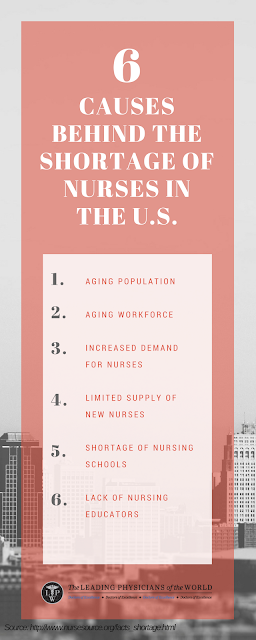Nurse Shortage Causes
The nursingshortage is not a recent phenomenon. In fact, it has been occurring since long
time ago. It is however, only in the last few years that the shortage has begun
to have a significant impact on our healthcare systems. The population growth,
a declining number of applicants to nursing schools, an aging workforce and a
baby boom generation that will require healthcare services in the coming years
are all contributing to this situation.
The cause
of the current shortage is actually three-fold: an aging population, an aging
workforce, and a limited supply of new nurses.
●An Aging Population– The baby
boomers are going into their golden years. It is estimated by between 2010 and
2030, one in every five people will be a senior citizen.
●An Aging Workforce– As the
population ages, so does the nursing staff. Approximately one-third of the
current nursing workforce is 50 years old or older.
●A Limited Supply of New Nurses–
There is a limit to the budgets and staff of nursing schools resulting in
graduating students. In other words, there are only so many new nurses entering
the workforce each year and it’s not enough to cover the deficit created by
those who will soon retire.
●Age - The lack of younger people
entering nursing has risen the average age of nurses. In Maryland, for
instance, the average practicing RN is 46 years old, whereas nationally the
average working RN is over 43 years old. About half of the RN workforce will
reach retirement age in the next 15 years. On top of this, the average age of
new RN graduates is 31. Nurses are entering the profession at an older age and
offer fewer years of work.
Declining Enrollment and Educators
New
admissions into nursing schools have dropped significantlyin the past six
years. Moreover, nursing colleges and universities denied 32,617 qualified
applicants in 2015 due to the shortage of nursing educators. Faculty age
continues to climb; higher compensation can be found elsewhere luring potential
educators away from teaching. The Health Resources and Services Administration
stated in a report that, "to meet the projected growth in demand for RN
services, the United States must graduate 90 percent more nurses."
Professional Alternatives
As new
opportunities have opened up and stresses have been added to the profession,
many are opting to choose other careers besides nursing. Women and men are
weighing their interests with a career choice that will bring them worthy
compensation as well as enhancing their quality of life. Unfortunately, nursing
is currently falling short on both of these. Women are now pursuing many
competitive, attractive, and lucrative careers that were impossible to achieve
thirty years ago. Women are entering law school, medical school, and the
corporate world in droves. Research indicates that 35% fewer women would choose
nursing as a career in the 1990s than they would have in the 1970s.
Research
has associated nursing staff that have more formal education and better work
environments with significantly better patient outcomes. This lack of
nursing empowerment may be a problem in any nation or setting, though it may be
more obvious in areas where training resources are rare and social attitudes
may inhibit nurses from advocating for their patients or themselves. Because
studies have shown that the media has a significant impact on
health-related views and actions, nursing's generally poor, inaccurate media
image is a major factor in the current crisis. It is believed
that the global nursing shortage cannot be resolved until public understanding
of nursing dramatically improves.




Comments
Post a Comment